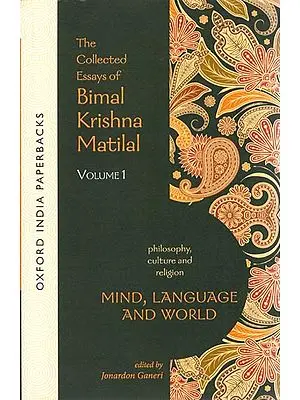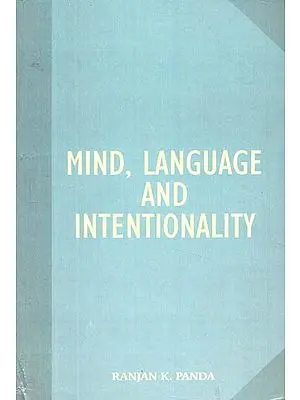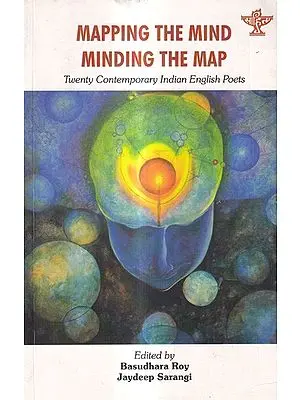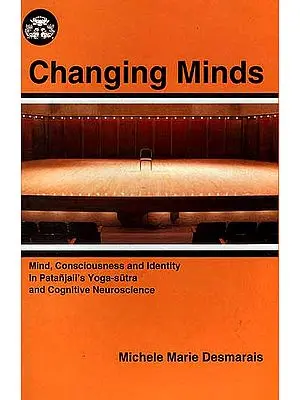Language and Mind (Volume 2): The Classical Indian Perspective
| Item Code: | IDK811 |
| Publisher: | Decent Books |
| Author: | K. S. Prasad |
| Language: | English |
| Edition: | 2008 |
| ISBN: | 8186921451 |
| Pages: | 255 |
| Cover: | Hardcover |
| Other Details | 8.8" X 5.7" |
| Weight | 480 gm |
The relation between language and mind is a fascinating area in both the Western and the Indian philosophers of language raise the question: How does the hearer derive knowledge from the speaker's utterances? In the process of finding an answer, they developed some important insights into language and cognition, language generated awareness, etc. In many of their formulations the concept of mind is assumed as the background of linguistic activity. This volume throws light on various language and mind as conceived in the Classical Indian Tradition.
Papers in this volume have been arranged in three groups based on their thematic composition: (1) the inadequacy thesis proposed by the Madhyamika school of Buddhism and the Vedantins which suggests that language fails to express certain experience; (2) the identity thesis held by the Grammarians which suggests that language is the Reality; and (3) the adequacy thesis supported by the Naiyayikas which suggests that whatever exists is capable of being known and whatever is known is capable of being expressed in language.
This book is the second of a two-volume project dealing with language and mind. The first dealt with the Western perspective and the present work deals with the Classical Indian Perspective.
K.S. Prasad is Reader in the Department of Philosophy at the University of Hyderabad. He obtained his PhD in Indian Epistemology and is teaching Indian Philosophy since 1984. He specializes in Philosophy of Nyaya-Vaisesika and Philosophy of language in Classical Indian Tradition.
It has all through been assumed in the Western philosophical and linguistic traditions that there is a close connection existing between language and mind. The strongest and probably the clearest version of this connection is found in Descartes. According to Descartes, what distinguishes humans from animals is that the former possess a thinking faculty. It is a faculty which expresses itself through human action and linguistic behaviour. Language is thus conceived as intrinsically related to mind giving rise to the idea that it is a mental organ. This idea of language being a mental organ gets its overwhelming support from the recent studies in philosophy of mind, Chomskian linguistics and cognitive science.
In the classical Indian philosophical tradition the connection between language and mind in general was never denied. However Indian philosophers of language do not perceive the relationship between language and mind in the same way as Western philosophers do. It is well known that the Indian notion of mind (manas) is essentially different from the Western perspective of mind. In the Indian context mind is used as an instrument, so to say an internal organ (antahkarana) for knowledge acquisition. The concept of mind, thus in India tradition, being an instrument or sense-organ is assumed to be devoid of consciousness. Consciousness has a separate locus and is associated with soul (atman). Basically we are not entering into these theoretical details pertaining to Indian notion of mind in this volume. Our thrust is to discuss the role of mind (in whatever form) in language comprehension. Keeping this objective in view, we are using a broad-based notion of mind which includes consciousness also. The word mind is used here more as a cover term to include internal states of existence such as different mental states, thought and thought processes.
In the Indian philosophical tradition, the problem regarding the interface between language and mind arises due to certain specific needs. Indian philosophers of language raise the question: How does a hearer derive knowledge from a speaker's utterances? In the process of solving this issue, they developed some of the most important insights into language and cognition, language-generated awareness, the distinction between knowledge and understanding, etc. These issues may not always explicitly address the interaction between language and mind. But in many of their formulations the concept of the mental is assumed as the background of linguistic activity. By and large the main objective of the present volume is to explore the details of the point of contact between language and mind as conceived by the classical Indian philosophers. In fact, all schools of Indian philosophy considered language at some stage or other and each one had to ponder over questions concerning the relation of the word to reality and the validity of verbal testimony (sabda) as a source of valid knowledge (pramana). However their metaphysical bias determined their answers to these questions.
Philosophical analysis of language in India emerged as a discernible field of intellectual activity since time immemorial. With certainty we can trace the beginning of speculation on language back to the Vedas, the Brahmanas and the Upanishads. In Rgveda several hymns are devoted to vak (the power of speech) and the same trend continued in the Brahmanas and the Upanishads.
Broadly, in the classical Indian philosophical tradition, we come across three distinct views regarding the relation between language and Reality. The realists, notably the Naiyayikas are of the view that language is competent to describe everything that is there. Whatever exists is potentially capable of being known and whatever is known is known is capable of being expressed; is their view. In contrast there is a dominating view which says that language is not equipped to express the nature of Reality. It is a view held by the Madhyamika school of Buddhists and the Advaita Vedantins. In contrast the view that 'language is the Reality' is held by the Grammarians. Thus the relation between language and Reality can be addressed from these three different perspectives namely adequacy, inadequacy and identity. The volume begins with the inadequacy thesis proposed by the Madhyamika school of Buddhism and the Vedantins which suggests that language fails to express certain experiences. This is followed by papers dealing with the identity thesis held by the Grammarians which suggests that language is the Reality. When the Grammarian describes the Reality as sabdabrahman he neither means any articulate word form which is regarded as an evolution of the transcendental principle nor sound which is viewed as the medium for manifestation of the transcendental principle on the empirical plane. Sabdabrahman for Grammarians is the Supreme Reality which is subtle and transcends all that comes within the purview of human experience. This sabdabrahman is regarded as the material cause of the phenomenal world and is found to persist in every manifestation inasmuch as every object in the universe is determined by a verbal form. The volume ends with the adequacy thesis supported by the Naiyayikas which suggests that whatever exists is potentially capable of being known (jneyatva) and whatever is known is capable of being expressed in language (abhidheyatva).
How language is connected to things or objects of the world is a question which has been the major preoccupation of both the Indian and Western philosophical traditions. Purushottama Bilimoria in his paper "Bimal Matilal's Navya-Realism, Buddhist 'Lingo-Phobia' and Mental Things" takes Bimal Matilal's work to be central to the issue concerning the relationship between language and the world. Matilal while developing his approach brought many of the issues and view-points which were pertinent to the basic theme. It was indeed a comprehensive approach to the subject. Essentially, Matilal adopts the Nyaya-Vaisesika approach which assumes a realist perspective of the relationship between language and the world. Through this perspective he seeks to construct a realist metaphysics being supported by a theory of language appropriate to it. It is due to adopting the realist approach, that Matilal finds that the Buddhist critique of language is unacceptable and characterizes the stand taken by Buddhism as lingophobia.
Bilimoria gives an analytic account of how Matilal develops a realist theory of language within the Nyaya and Navya-Nyaya, the issue of language mainly arises while dealing with jnana or cognition. Cognition is always cognition of something, i.e. directed towards an object and is always expressed through some verbal form. There is an influential view in Indian epistemology which says that cognition necessarily consists of a sensory core required for the construction of particulars. Such a perspective denies any causal connection between the internal sensory experience and the external object of awareness. This sensory core remains ineffable. Matilal, as Bilimoria argues, seeks to show that this view is not unconnected to the view of language that it holds. Dinnaga and many other Indian philosophers including Candrakirti arrive at this view of cognition due to their supposition that private language is possible. But Matilal refutes this view by using the argument especially of Quine and Wittgenstein that language is a social behaviour. Wittgenstein's private language argument shows that the idea of language being private is unintelligible and thus to hold that private sensory experience can be expressed through language is equally unintelligible and logically incoherent. This is the reason why Buddhist critique of language, as Matilal claims, turns into a lingophobia that reduces mental things as mere mythical. The Nyaya view, on the other hand claims that any cognitive experience must be expressible in language. Gangesa rules out the presence of the ineffable sensory core to be the essence of cognition on the ground that it is merely physical and is thus non-cognitive. Matilal interprets this, according to Bilimoria, to be a version of metaphysical realism which argues for an inseparable connection between language and cognition. As Bilimoria puts it, it is a "linguistically compromised doctrine of knowing."
Langrage, according to Buddhists in general, is considered as vikalpa, so to say a mental construct devised to assist in day-to-day life and it is not capable of depicting or revealing the nature of Reality. The realistic standpoint that "knowability is co-extensive with expressibility" is not acceptable to Buddhism is knowable and yet inexpressible. The Absolute, according to Acarya Nagarjuna, an exponent of Madhyamika Sastra, is transcendent to both thought and speech. C.D. Sebastian in his paper "Language and Mind: A Madhyamika Perspective" is of the view that Madhyamika has language which does not have syntax but semantics and he terms it as the language of silence. In the Madhyamika school of Buddhism we find a clear-cut distinction between the realms of things-in-themselves and commonsense-experiences which are termed as sva-laksanas and samanya laksanas respectively. The former is the sphere of paramartha satya, i.e. transcendental reality while the latter is the sphere of samvrtti satya, i.e. empirical reality. Whatever comes within the realm of empirical experience is characterized as mentally constructed, imagined and linguistically expressible. On the other hand, the transcendental experience is untouched by mental construction, imagination and is beyond the realm of language which is termed as sunyata in Mahayana Buddhism. Sunyata on the logico-linguistic level, as Sebastian argues, then means accepting the failure of predicate language as a viable mode of discourse. The Madhyamika standpoint in this sense, as he concludes, does not have a first-order language.
The study of language necessarily leads to the study of what it means. But the word-meaning, in classical Indian philosophical tradition, was never confined to the verifiable meaning only. Its scope was extended to include metaphysical expressions. Metaphysical statement sense. R.C. Pradhan in his paper "Language and Mind in the Upanishads" has suggested that the language of metaphysics is always different from the language of ordinary objects. He introduces a distinction between natural language, while it is suitable for describing the phenomenal world, is grossly handicapped to express the transcendental reality. Metaphysical language though fails to have cognitive meaning as found in natural language is not devoid of meaning altogether. The uniqueness of metaphysical language, according to Pradhan, lies in its introduction of non-natural meaning which takes us back to the Reality. The metaphysical statements such as, tat tvam asi, ayam atma brahman, prajnanam brahman, aham brahmasmi have the deeper import of conveying the essential identity of Brahman and jiva as pointers. However, Pradhan rightly points out that Ultimate Reality cannot be known except by one's own direct realization (aparoksanubhuti). While emphasizing the revelatory character of Reality, Pradhan brings in the philosophy of Wittgenstein and Heidegger to substantiate his point.
G. Mishra in his paper "Limits of Mind and Universe of Language" has a twofold objective. The first is to show the relation between language and mind in Indian philosophy in general and the other is to explain the thesis proposed in Advaita Vedanta that there is a need to transcend both language and mind to attain a higher level of Reality identified as Brahman. Attaining such a state is usually described as a state of emancipation an emancipation from empirical bondage. Language and mind do not have ultimate validity since they belong to the empirical world which is not real from the ultimate standpoint. Mishra while explaining the nature of mind examines major philosophical theories in the Indian context and takes paints to prove that it is not an internal sense-organ as understood in certain philosophical schools such as Nyaya. Advaita Vedanta while emphasizing the nature of Reality in terms of Pure Consciousness emphatically pronounces the illusory nature of mind and language. Taking a clue from the Upanishads, Mishra argues a case for Advaita Vedanta. Sruti vakyas which are the only means of the knowledge of Brahman, according to Advaita Vedanta turns out to be illusory on the onset of Brahman realization. To the question: how can an illusory sruti vakya be a means for the Real, the Advaitins argue that just as an illusory snake which can create a real fear in the cognizer, so also the sruti vakyas though illusory in nature, can help in realizing the Brahman. Mishra elucidates this point succinctly with an empirical illustration. Mishra argues that just as words that are no linger useful after conveying their sense in an ordinary discourse, similarly the sruti vakyas also cease to be authoritative on the onset of the knowledge of Brahman.
From the Advaita standpoint of language and mind the next issue that arises is regarding the relationship between language and consciousness. To be conscious means to be conscious of the world around us, the environment where we live and the life that we share with other people. Consciousness is inclusive of all our cognitive and mental states such as understanding, desire, feeling, etc. The defining feature of these states is that they are always directional, i.e. directed towards the world. Keeping this feature in mind, Brentano in the Western tradition defines consciousness in terms of intentionality. However, this approach to consciousness does not define what consciousness is, i.e. what consciousness is per se and how to identify it. We find such a task difficult. In fact, to define what consciousness is in linguistic terms can often be found to be inadequate if not futile. It is in this context that Meera Chakravorty's paper "Language and Consciousness: The Advaita Perspective" assumes its significance. For Advaita, consciousness is the ultimate basis of all that exists. Everyone is conscious of his own existence and never thinks he is not. In fact, it is impossible to entertain any doubt itself is an expression of consciousness. It is a self-evident reality. Further, it is that without which even the subject-object relationship becomes an impossibility; it is that which really exists as compared to that which has got phenomenal, temporary and relational existence. From this very consciousness of the self, Advaitins arrive at the existence of an infinite, eternal Universal consciousness which is free from predication. However, in the phenomenal world this non-relational, non-predicative nature of consciousness, as Chakravorty argues, changes its chapter because it is viewed differently. It is due to our inclination towards the objective standpoint that consciousness is defined in terms of observable attributes. In the phenomenal world, consciousness is thus always viewed as conscious of something which can be articulated in language. Chakravorty argues that there is a strong tendency to see the objective world and the mind as mutually incompatible since the one resists any fixed interpretation by the other and vice versa. If we take unsublatability (abadhitavisayatva) as the criterion for Reality then the dream experience is contradicted by the transcendental experience of pure consciousness which cannot be expressed in language. Failure to express is not something unique to transcendental experience alone. It is a fact that we have all felt certain things at certain privileged moments in our day-to-day lives, that words fail to describe. "The challenges presented by consciousness," according to Chakravorty, "impede our ability to develop a coherent linguistic expression of consciousness directed to certain experiences mentioned above." She suggests that instead of drawing a definite linguistic correlate of consciousness it would be appropriate to have a detailed survey of linguistic expressions which have been invented and used in different fields such as quantum physics, mythology, esoteric teachings, biology, philosophy, mysticism, poetry, etc. for understanding and describing the different aspects of consciousness. This may provide valuable clues that can explain the linguistic relation with consciousness.
We are all exposed to a variety of experiences and surely all are not of the same value. The cognitive content of one experience may at times come into conflict with the other and claim for greater reality which in turn may be contradicted by the other. Philosophy must rationally discriminate between one experience and the other and assign a proper place to each. In the light of such rational grounds the Advaitins classify all our experiences. In grading these experience they followed the principle of unsublatability (abadhita). Momentary experiences such as dreams are sublated by the walking experience which in turn is sublated by a transcendental experience which is neither contradicted nor contradictable. Thus according to Advaita the principle of unsublatability which forms the criterion to validate an experience, states that an experience which is unsublatable at all times (trikala-abadhita) is real. It rules out a situation where an experience which is at one time and is not at another time cannot be real. However, in all our phenomenal experiential episodes there is a transition of thought from sensation to determination, so to say from nirivikalpaka to savikalpaka. To determine a sensation is to predicate it in terms of substantive-adjective relation (visesya-visesana sambandha) and is termed as savikalpaka jnana, while nirvikalpaka is the knowledge of a thing as not related to anything, not even to itself. It is the knowledge of the identity of a thing as excluding all relations. Identity propositions such as 'This is that man' and the like according to Advaita are non-predicative and non-relational in nature. Vinay Kumar in his paper "Advaitic Language of Sublation" interrogates the role of language in all these experiences. Using the analogy of a postman who faithfully delivers the goods without tampering the contents, he argues that at least in the case of tuccha vakyas language acts like a not-so-trustworthy postman as there is no cognitive content in tuccha vakyas. Through an analysis of language Vinay Kumar concludes that what remains finally is the pure undifferentiated consciousness which does not need any postal articles to be delivered by the postman.
Indian philosophers belonging to different schools of thought in general emphasize the role of language in the context of cognition. Bhartrhari argues for the inseparability of cognitive faculty from verbal faculty. According to him, verbalizability is immanent in our cognitive faculty. To cognize is to verbalize and in the same way to verbalize is to cognize. This may be characterized as an inextricability thesis which is possible due to the deeper relationship between language and thought. The relation between language and thought is so intimate that we cannot conceive of the possibility of one without the other. It is a well-known fact that we cannot isolate thinking from language for there are no meta-linguistic modes of thought. All thinking is invariably carried out in language. Language is not just a vehicle of thought but it constitutes a vital part of thought. Tandra Patnaik in her paper "Thought and Language: The Bhartrharian Perspective" tries to explore Bhartrhari's views of this issue. She approaches the problem from two important dimensions (i) thought and language as components of linguistic communication, and (ii) thought and language as conceptual entities and their relative priority. According to her, Bhartrhari prefers to prioritize language over thought. For Bhartrhari the Supreme Reality is the sabdabrahman which is subtle and transcends all that comes within the purview of human experience. The words we speak are momentary and are simply the manifestations of the sabdabrahman. Committed to non-dualism, Bhartrhari never maintained an absolute distinction of thought and language. Just as the empirical world cannot be established apart from and independent of consciousness, similarly consciousness in the sense of awareness cannot be established apart from and independent of language. Tandra Patnik makes it abundantly clear that for Bhartrhari consciousness means linguistic consciousness and there cannot be any prelinguistic bare awareness. Thus, there is nothing without thought and there is no thought without language.
In the history of philosophy of language the place of Bhartrhari is quite significant. For the first time he undertook an in-depth study of the sabdabrahman, the Word-Absolute, and demonstrated its logical implications. Maharana is his paper "Bhartrhari on Word and Consciousness: The Advaita Perspective" seeks to explore the central philosophy of Bhartrhari from his work "Vikyapadiya. Further he tries to identity the relationship that can be drawn among Bhartrhari and the Advaitins like Sankara and Mandana Misra on the nature of consciousness. Thus the Grammarian is as much an advocate of non-dualism as Sankara is. However, Maharana points out that there are certain important points of difference between them. For Grammarians sabdabrahman in its essence is identical with kalasakti which is its eternal and innate power. In fact, the two may be regarded as aspects of the same Reality. As transcendent it is beyond time and it is above all predication in thought and language, and as immanent it is in time and it is the subject and predicate of all judgements. This kalasakti has no independent being apart from sabdabrahman and is eternally real unlike the maya of Sankara. The powers of the Brahman according to Sankara are illusory while for Bhartrhari the kalasakti of sabdabrahman is real and eternally present in the relation of identity.
Classical Indian thinkers, from the beginning, considered mind as something distinct from the Self. They regarded mind as an instrument directed by the Self and itself directing the other sense-organs is wonderfully illustrated with the help of a chariot in the Kathopanisad. In Indian Grammatical tradition we come across two aspects of mind the physiological component termed as buddhi and the transcendental component namely citta. Srimannarayana Murthy in his paper "Language and Mind in Grammatical Tradition" identifies the physiological component of mind with the empirical mind so to say the Brain which is responsible for all cognitions, while the transcendental mind is the one which controls the empirical mind. The communication of the mental disposition of the speaker to the listener is the purpose of language. In the science of language, according to Srimannarayana Murthy, the intention of the speaker should match with the physical effort in acoustics to bring out a correspondence with the empirical mind, which controls the articulatory process, with the transcendental mind, which governs the psychological process of the speaker and the listener. In order to account for continuity and consistency between the operations of the empirical mind and transcendental mind, the Grammarians maintained the eternality of the word, its sense and the relation between them. Bhartrhari, according to Srimannarayana Murthy, gave a new dimension to relate mind and language by propounding bauddhapadarthavada as the basis for understanding sphota, the meaning bearer, and pratibha, the meaning of a sentence, and vivarthavada to substantiate the transitory nature of the mental world.
Vyakarana (grammar) which is regarded as one of the Vedangas is considered to be the gateway for other disciplines. Vyakarana is taken to mean the process of analyzing language. the distinctive feature of Vyakarana is such that unlike the ordinary language wherein the use of the word such as ghata refers to its meaning, in Vyakarana the use of the word refers to the word itself. The basis purpose of Vyakarana is to distinguish correct word forms from incorrect ones. The nature of the word thus occupies an important place in the philosophy of language. Nrmalya Narayan Chakraborty in his paper "On the Nature of the Word and our Knowledge of it" has discussed the classical Indian Grammarian theory on the nature of the word. The study of grammar, according to him, leads to the knowledge of the word which in turn amounts to knowing the meaning of the word. The knowledge of the meaning of the word leads to the knowledge of the Upanishads which in turn leads to the knowledge of the Brahman which is regarded as a state of emancipation. Patanjali, according to Chakraborty, rejected any attempt to describe the nature of the words in terms of substance, quality action and universal. To set aside these wrong notions Patanjali, according to Chakraborty, explained the word in terms of dhavani, the manifestation of which produces the knowledge of it.
There is another view in classical Indian tradition which argues for the autonomy and irreducible character of linguistic utterances as a separate source of knowledge. The same has been recognized as verbal testimony in the Western philosophical tradition. The most exhaustive account of this knowledge is found in Nyaya, which gives rise to the thesis called sabdabodha. The Nyaya considers language-generated knowledge as a separate type of prama, as its causal inheritance can neither be understood in terms of perception or inference or comparison. In my paper "The Centrality of Mind in Cognitive Process: The Nyaya Perspective," I have discussed in detail the notion of cognition in Nyaya philosophy and the centrality of mind in the cognitive process. The purpose of sabdabodha thesis of Nyaya is to show how there is a close connection between linguistically-generated knowledge and mind.
In these papers there has been an attempt to discuss a number of issues philosophers are concerned with from time to time in the area of philosophy of language and mind. One important aspect to language is that the articulate linguistic forms of language and thought are intrinsically incapable of expressing the full knowledge of the Reality on the empirical plane. However, these forms of language though fail to express the Reality in full and present only a vague picture of it, still help as a pointer to the Reality. It is this function of language which in its effort to realize the Ultimate Reality. In fact, the articulate linguistic form of language shadows the Reality and is meaningful because of it.
| Acknowledgement | vii | |
| Introduction | 1 | |
| 1. | Bimal Matilal's Navya-Realism, Buddhist 'Lingo-Phobia' and Mental Things | 17 |
| - Purushottama Bilimoria | ||
| 2. | Language and Mind: A Madhyamika Perspective | 33 |
| - C.D. Sebastian | ||
| 3. | Language and Mind in the Upanishads | 51 |
| - R.C. Pradhan | ||
| 4. | Limits of Mind and Universe of Language | 69 |
| - Godabarish Mishra | ||
| 5. | Language and Consciousness: The Advaita Perspective | 85 |
| - Meera Chakravorty | ||
| 6. | Advaitic Language of Sublation | 101 |
| - U.A. Vinay Kumar | ||
| 7. | Thought and Language: The Bhartrharian Perspective | 127 |
| - Tandra Patnaik | ||
| 8. | Bhartrhari on Word and Consciousness: The Advaita Perspective | 147 |
| - S.K. Maharana | ||
| 9. | Language and Mind in Grammatical Tradition | 159 |
| - M. Srimannarayana Maruti | ||
| 10. | On the Nature of the Word and our Knowledge of it | 185 |
| - Nirmalya Narayan Chakravorty | ||
| 11. | The Centrality of Mind in Cognitive Process: The Nyaya Perspective | 215 |
| - K. S. Prasad | ||
| Index | 239 |
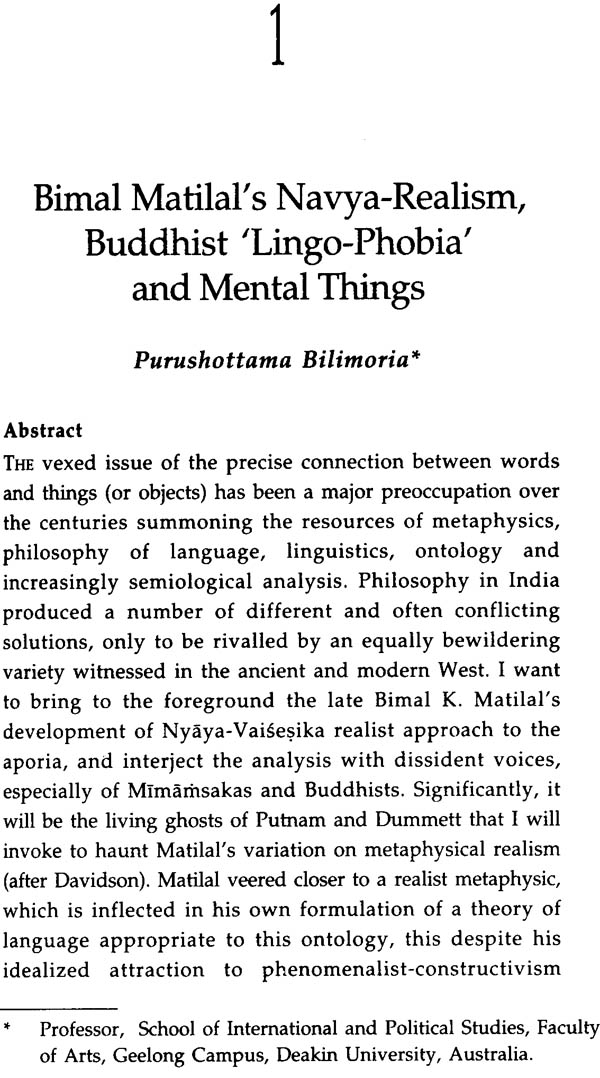
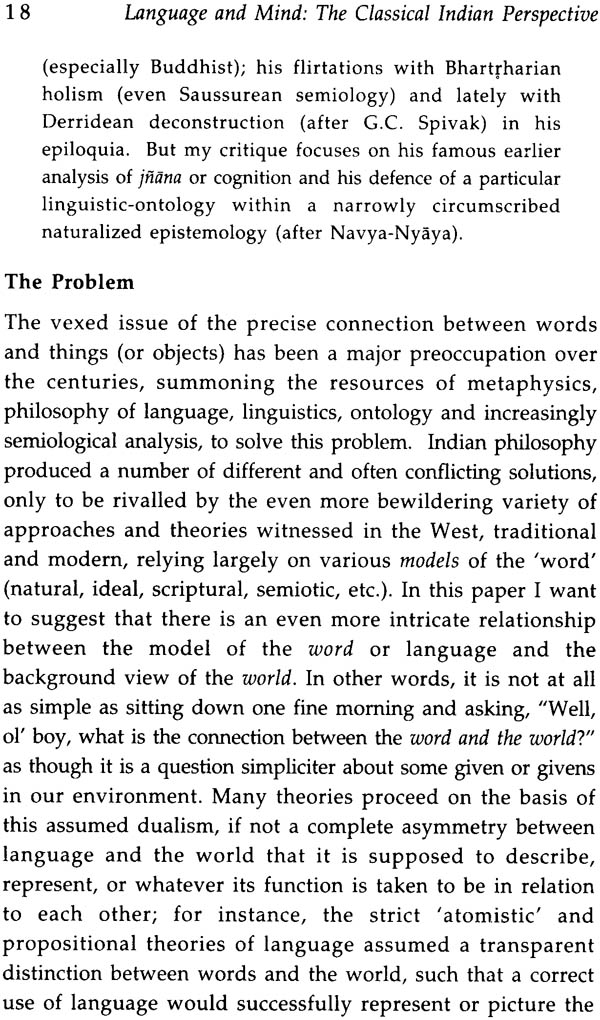
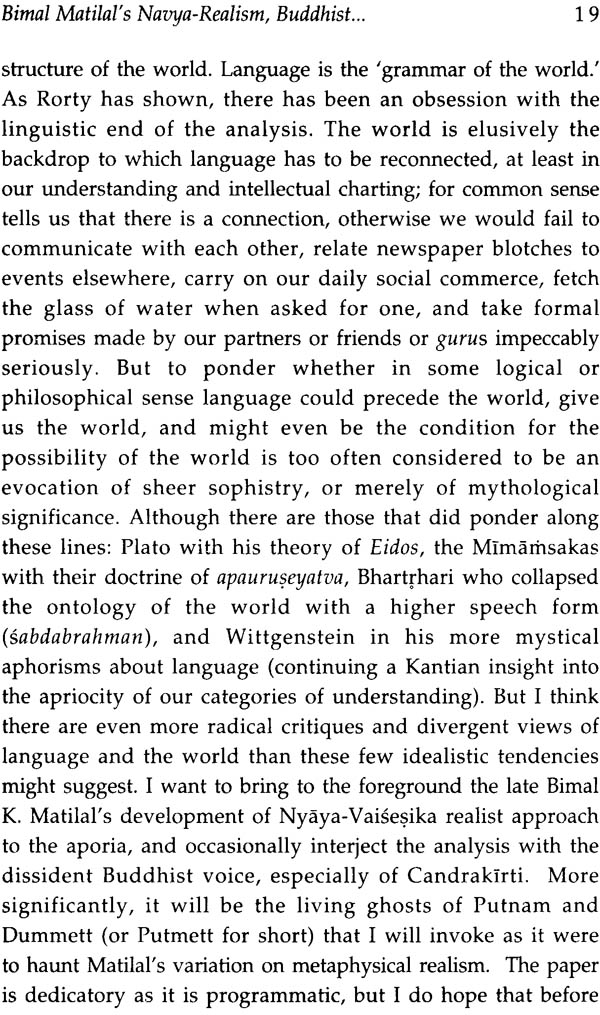

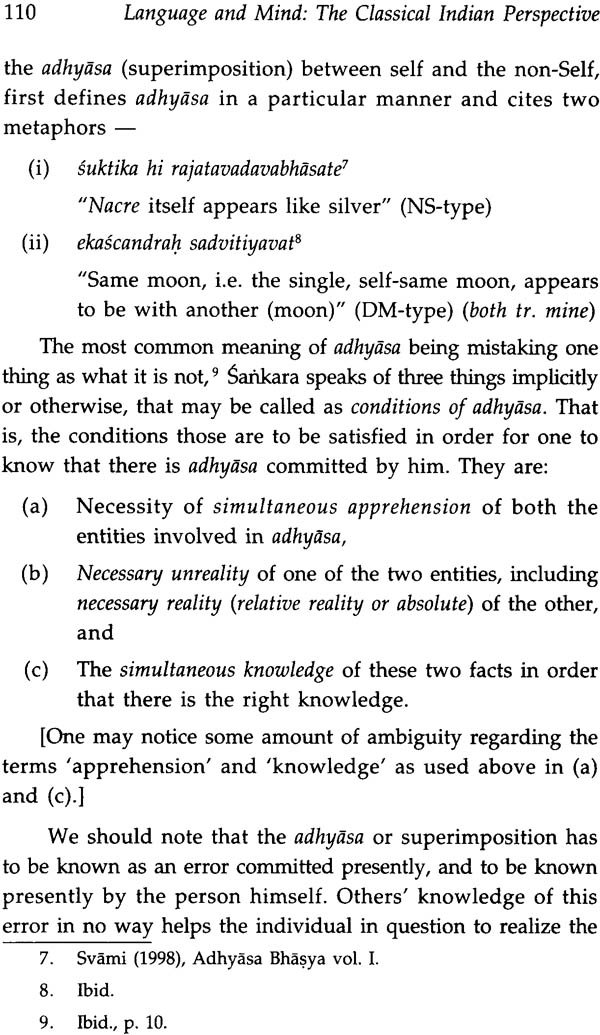
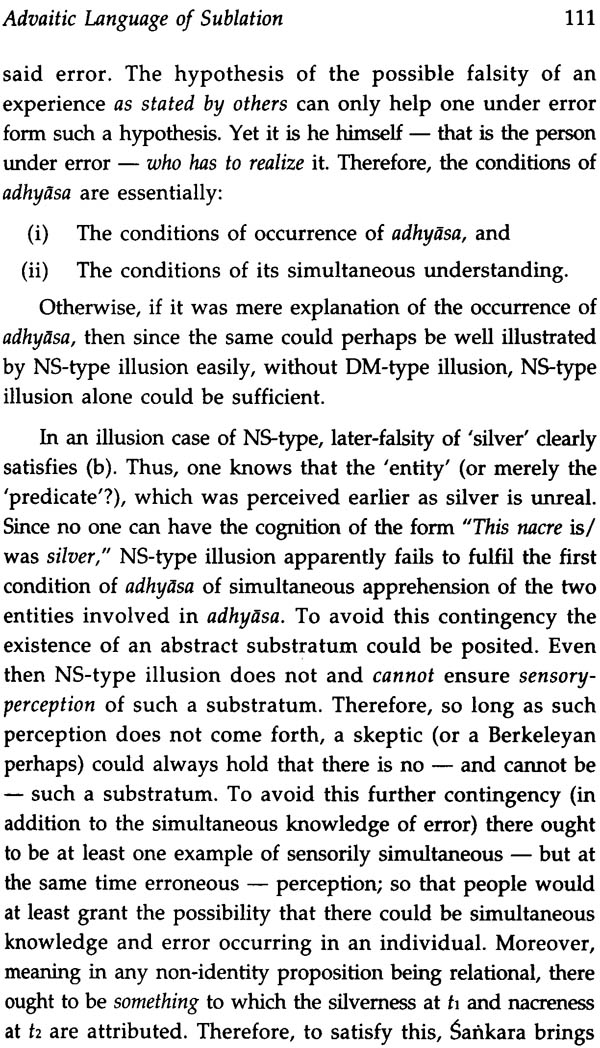
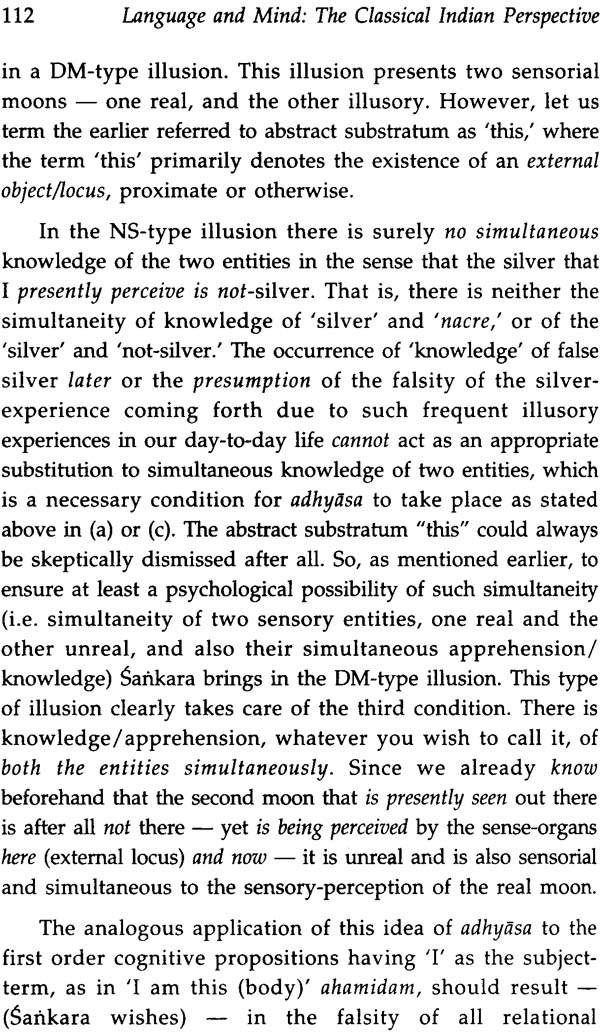
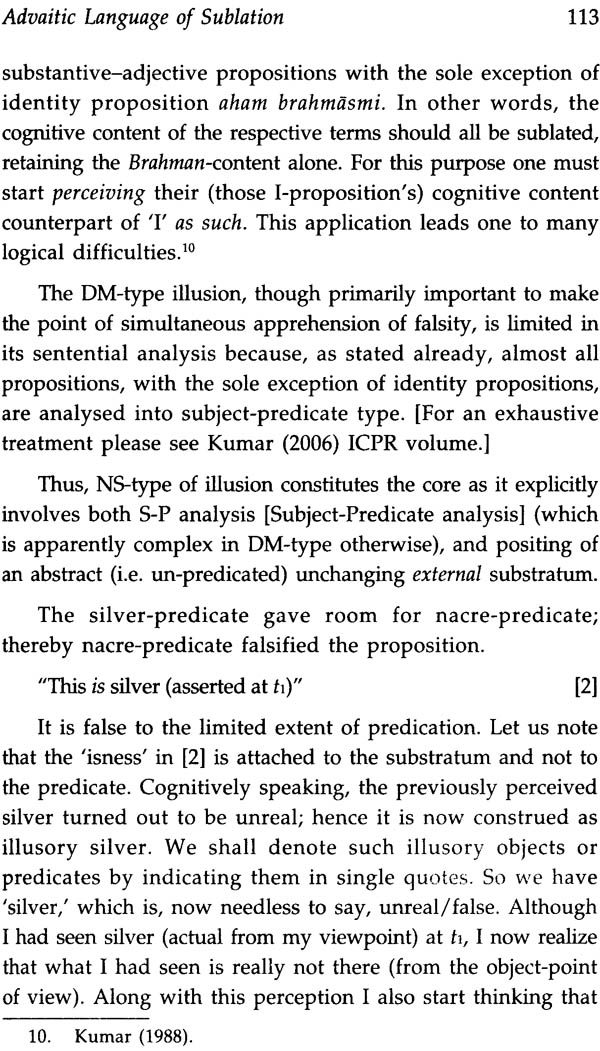
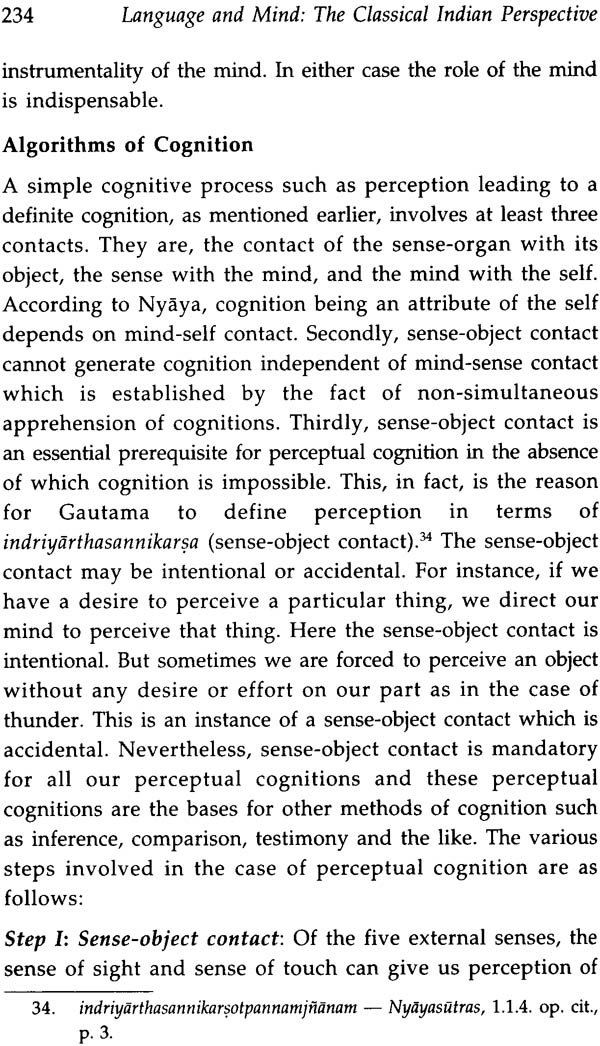
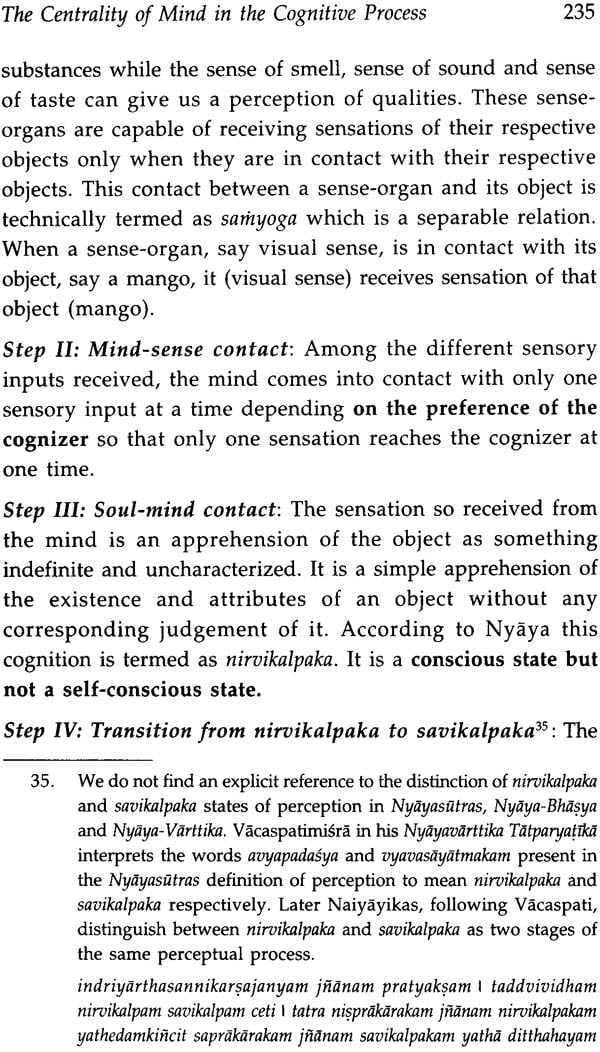

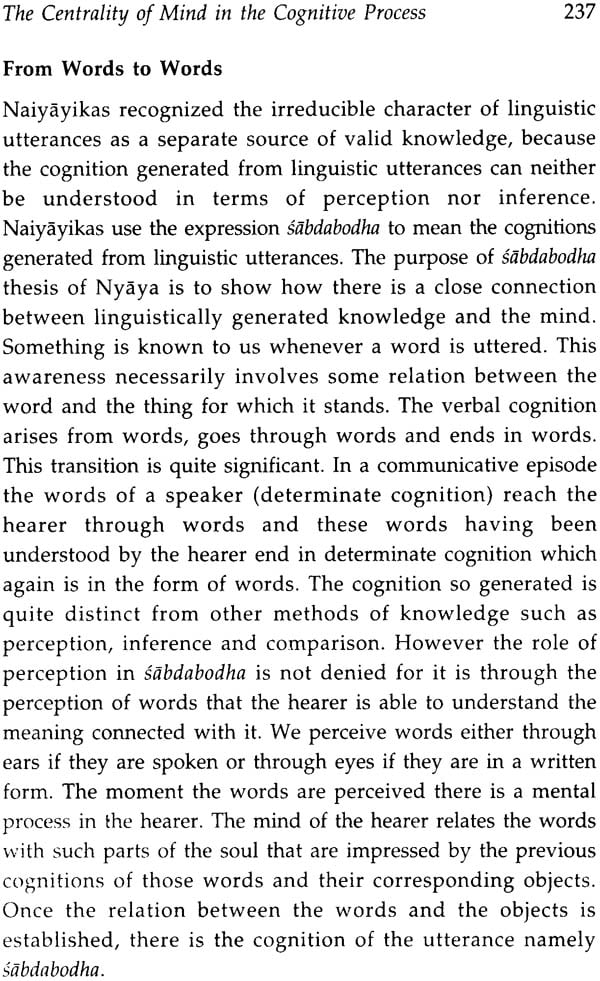
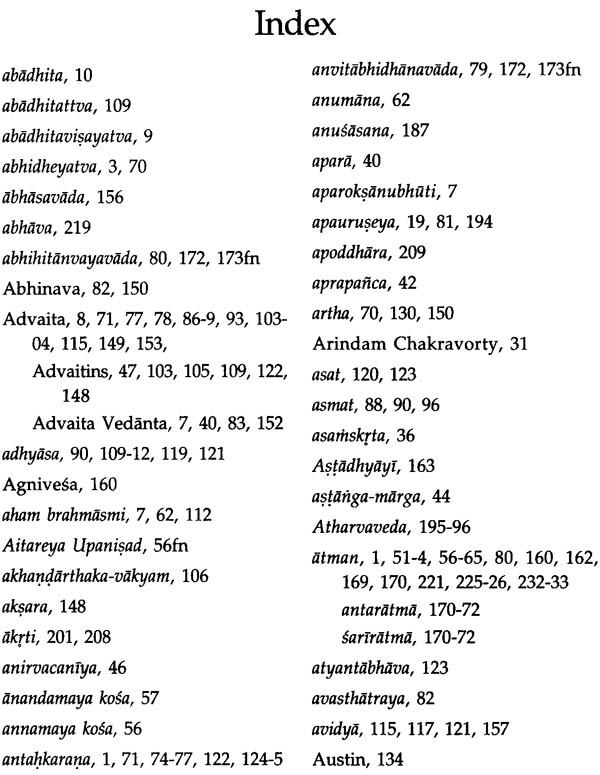
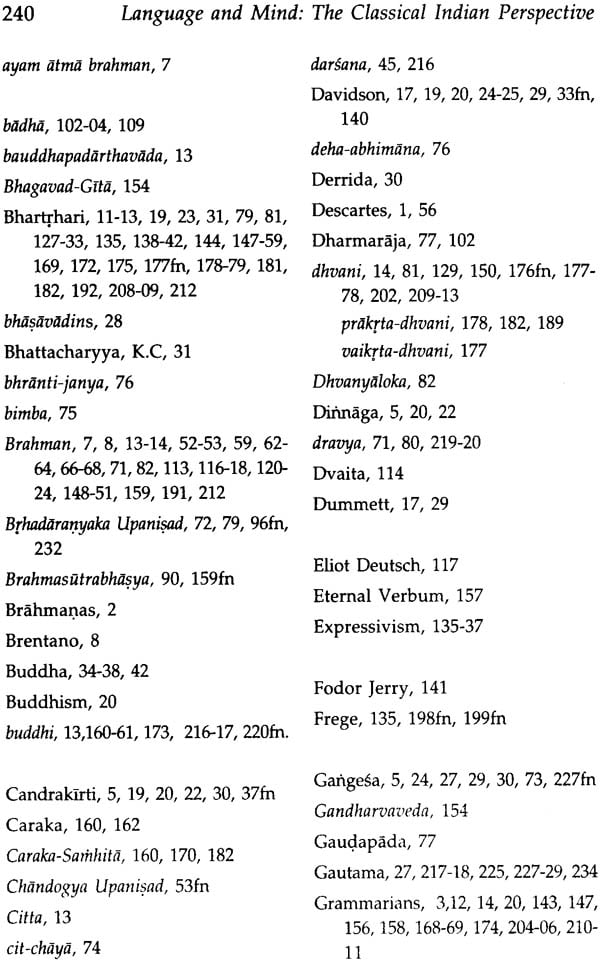
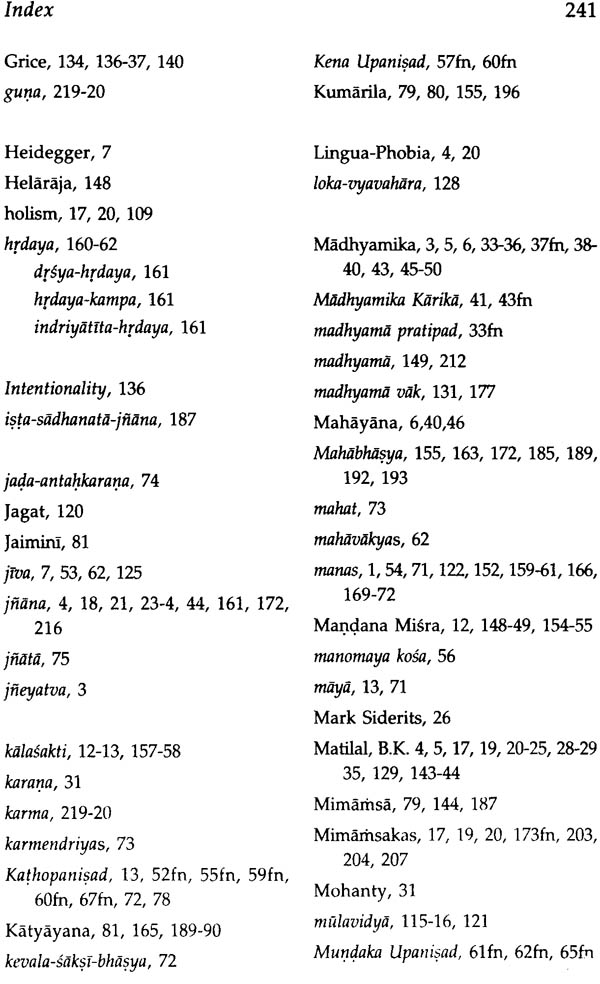

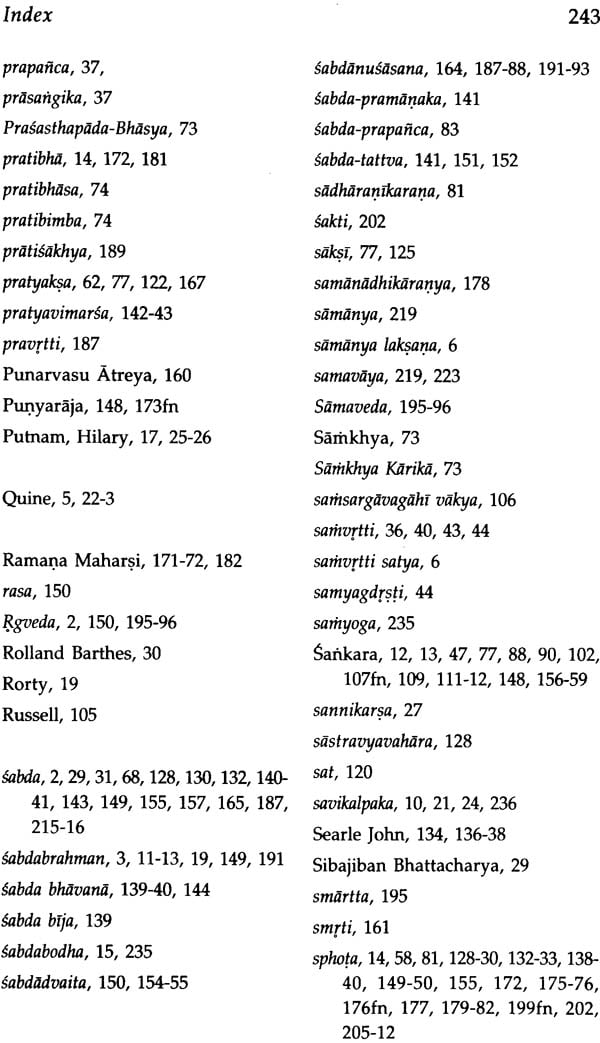
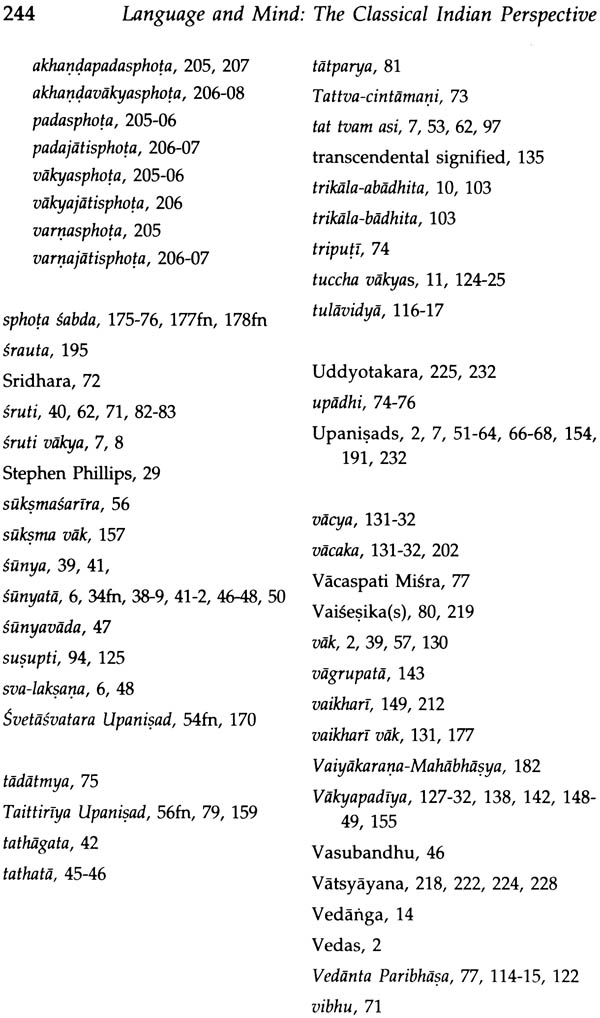
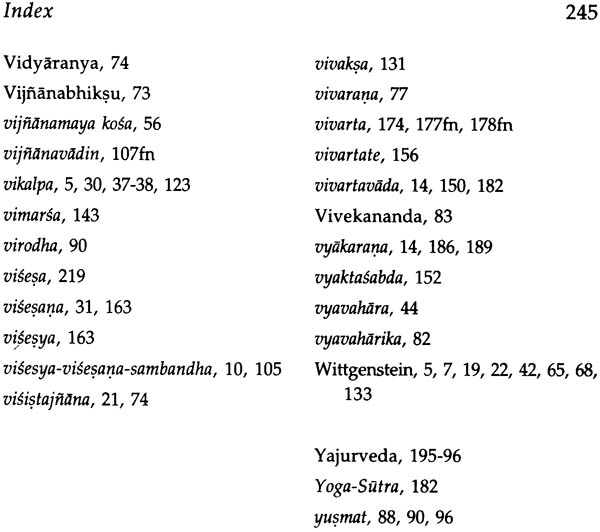
-
Q. What locations do you deliver to ?A. Exotic India delivers orders to all countries having diplomatic relations with India.
-
Q. Do you offer free shipping ?A. Exotic India offers free shipping on all orders of value of $30 USD or more.
-
Q. Can I return the book?A. All returns must be postmarked within seven (7) days of the delivery date. All returned items must be in new and unused condition, with all original tags and labels attached. To know more please view our return policy
-
Q. Do you offer express shipping ?A. Yes, we do have a chargeable express shipping facility available. You can select express shipping while checking out on the website.
-
Q. I accidentally entered wrong delivery address, can I change the address ?A. Delivery addresses can only be changed only incase the order has not been shipped yet. Incase of an address change, you can reach us at help@exoticindia.com
-
Q. How do I track my order ?A. You can track your orders simply entering your order number through here or through your past orders if you are signed in on the website.
-
Q. How can I cancel an order ?A. An order can only be cancelled if it has not been shipped. To cancel an order, kindly reach out to us through help@exoticindia.com.

